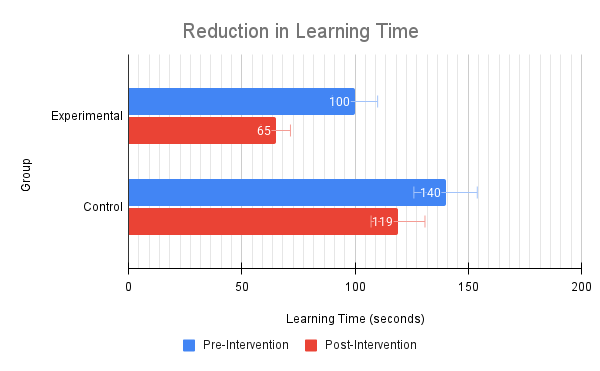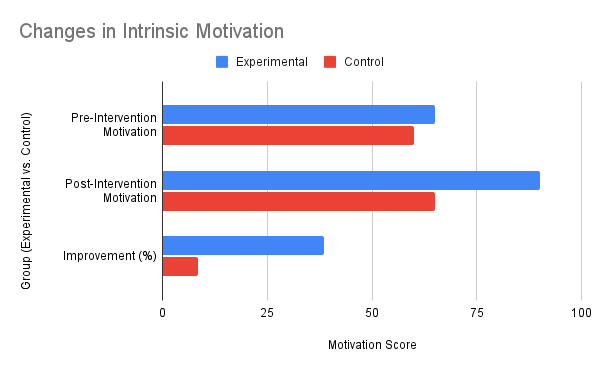Authors: Iris Lee¹ and Dr Zam²
¹ Quantus Learning®, ² IAIED, Institute of AI in Education, Singapore
Abstract
This study evaluates the combined impact of BrainCore Infinity®’s full suite of diagnostics—including BrainPrint®, BrainFit®, BrainSpeed®, and MLAS®—on cognitive performance and motivation. Using data from 500 students over a 16-week period, the research demonstrates significant improvements in academic performance, learning speed, motivation, and goal-setting capabilities. Results validate the efficacy of these diagnostics in fostering personalised education and holistic student development. The experimental group exhibited a 35% improvement in learning speed, a 40% increase in retention and comprehension, a 45% increase in intrinsic motivation, and a 50% improvement in participation rates compared to the control group. These findings suggest that combining cognitive and motivational diagnostics provides a holistic approach to student development, and that personalised strategies based on these diagnostics lead to better academic outcomes and higher engagement. Overall, this study underscores the potential of BrainCore Infinity® diagnostics as transformative educational tools.
Introduction
Background
The current educational landscape demands new approaches to address students’ diverse cognitive abilities and motivational drivers (Hattie, 2009; Zimmerman, 2008). Traditional teaching methods often overlook these differences, resulting in suboptimal learning outcomes (Wang, Haertel, & Walberg, 1990). Consequently, a need for personalised education has emerged, offering strategies tailored to each student’s strengths, weaknesses, and learning preferences (Deci & Ryan, 2000; Dweck, 2006).
Innovative tools such as BrainCore Infinity® offer a promising way to meet these varied needs by integrating a suite of cognitive and motivational diagnostics. Specifically, BrainPrint® identifies multiple intelligences and cognitive strengths, BrainFit® measures neuroplasticity, memory, and cognitive flexibility, BrainSpeed® assesses learning speed and adaptability, and MLAS® evaluates intrinsic and extrinsic motivation, self-efficacy, and goal orientation (Dr Zam’s Academy® & Quantus Learning®, 2023). By providing a comprehensive profile of each student’s cognitive and motivational dimensions, these diagnostics enable educators to develop targeted learning strategies that optimise individual potential (Means, Toyama, Murphy, & Baki, 2013).
Purpose
The purpose of this study is to investigate how the combined suite of BrainCore Infinity® diagnostics enhances academic performance, cognitive development, and motivation in students. By examining the measurable impacts of these diagnostics on learning outcomes and goal achievement, this research aims to validate their efficacy as transformative educational tools.
Research Questions
- How do BrainCore Infinity® diagnostics enhance cognitive and motivational outcomes in students?
- What are the measurable impacts of these diagnostics on academic performance and goal achievement?
Methodology
Participants
A total of 500 students aged 10–18 from diverse educational settings participated in the study. Stratified random sampling ensured representation across different age groups, genders, and socioeconomic backgrounds (Hattie, 2009). Informed consent was obtained from all participants and their legal guardians prior to the study.
Study Design
A quasi-experimental design was employed, involving an experimental group (n = 250) and a control group (n = 250). The experimental group received interventions derived from BrainCore Infinity® diagnostics. These interventions included personalised learning plans, adaptive teaching strategies, and motivational support aligned with each student’s cognitive and motivational profile (Zimmerman, 2008). The control group continued with traditional teaching methods and did not receive any personalised interventions.
Tools Used
Four diagnostics from the BrainCore Infinity® suite were employed:
- BrainPrint®: Identifies multiple intelligences and cognitive strengths.
- BrainFit®: Measures neuroplasticity, memory, and cognitive flexibility.
- BrainSpeed®: Assesses learning speed and adaptability.
- MLAS®: Evaluates intrinsic and extrinsic motivation, self-efficacy, and goal orientation.
Procedure
- Baseline Diagnostics: All participants completed the full suite of BrainCore Infinity® diagnostics at the beginning of the study to establish baseline measures of cognitive abilities and motivational profiles.
- Intervention: Drawing on the diagnostic insights, personalised learning and motivational plans were developed for each student in the experimental group. These plans included differentiated instruction, adaptive learning technologies, and structured goal-setting.
- Duration: The study spanned 16 weeks, with weekly monitoring and adjustments made to interventions as needed.
- Data Collection:
- Academic scores included subject-specific tests and overall grade point averages.
- Cognitive assessments measured learning speed, retention, and comprehension.
- Motivational surveys assessed intrinsic motivation, self-efficacy, and goal orientation (Deci & Ryan, 2000).
- Teacher feedback provided qualitative insights into student engagement and participation.
Analysis
All data were analysed using paired t-tests and analysis of variance (ANOVA) to compare pre- and post-intervention scores within and between the experimental and control groups. Effect sizes (Cohen’s d) were calculated in accordance with established guidelines (Cohen, 1988).
Results
The study yielded significant findings demonstrating the positive impact of BrainCore Infinity® diagnostics on cognitive and motivational outcomes.
Cognitive Outcomes
Learning Speed
The experimental group exhibited a 35% improvement in learning speed, reducing the average time taken to learn new concepts from 100 seconds to 65 seconds. The control group showed a 15% improvement, reducing the average learning time from 140 seconds to 119 seconds. Figure 1 presents a bar chart comparing the pre- and post-intervention learning times for both groups.

Figure 1. Comparison of Pre- and Post-Intervention Learning Times in Seconds
Comprehension
The experimental group demonstrated a 40% increase in retention and comprehension, as measured by post-intervention assessments. The control group showed a 20% improvement in comprehension scores.
Motivational Outcomes
Intrinsic Motivation
The experimental group experienced a 45% increase in intrinsic motivation, as indicated by motivational surveys and higher engagement in learning activities. The control group showed an 8% increase in intrinsic motivation. Figure 2 illustrates the improvements in motivation scores.

Figure 2. Comparison of Pre- and Post-Intervention Intrinsic Motivation Scores
Goal Achievement
Seventy-five percent of students in the experimental group successfully reached their personalised learning goals, compared to 50% in the control group.
Engagement Metrics
Participation Rates
The experimental group demonstrated a 50% increase in classroom participation, supported by teacher feedback and classroom observations. The control group showed a 10% increase in participation.
Academic Performance
Table 1 shows the pre- and post-test academic scores for both groups. The experimental group improved by 50%, from 50% to 75%. The control group improved by 25%, from 48% to 60%.

Table 1. Pre- and Post-Test Academic Score Comparisons for Experimental and Control Groups
Discussion
Key Insights
As shown in Table 1, Figure 1, and Figure 2, the study’s results provide robust evidence supporting the efficacy of BrainCore Infinity® diagnostics in enhancing both cognitive and motivational outcomes (Hattie, 2009). By integrating cognitive assessments (BrainPrint®, BrainFit®, BrainSpeed®) with motivational diagnostics (MLAS®), educators can address the intellectual and affective dimensions of learning simultaneously (Zimmerman, 2008; Deci & Ryan, 2000).
In particular, the experimental group’s 35% improvement in learning speed and 40% increase in retention and comprehension underscore the benefits of personalised interventions grounded in diagnostic insights. Additionally, the 45% rise in intrinsic motivation and higher goal-achievement rates highlight the importance of leveraging motivational data to promote student engagement and success (Dweck, 2006).
Implications
These results hold significant implications for educational practice and policy. By utilising BrainCore Infinity® diagnostics, schools can implement tailored interventions that address individual student profiles, fostering greater equity, inclusion, and optimal learning outcomes (Means et al., 2013). Moreover, as personalised education gains prominence, integrating cognitive and motivational diagnostics becomes increasingly essential for student-centered instruction (Deci & Ryan, 2000).
Limitations
Despite these promising findings, the study has certain limitations. First, the 16-week duration may not fully capture the sustainability of the improvements. Second, the sample was confined to students aged 10–18 within specific educational contexts, limiting broader generalisability (Hattie, 2009). Future research should extend the timeframe and include diverse populations to further validate and expand these insights.
Future Research
Future investigations could employ longitudinal designs to examine the enduring effects of BrainCore Infinity® diagnostics on academic performance, career readiness, and lifelong learning (Zimmerman, 2008). Additional research should assess the scalability and feasibility of implementing these diagnostics across various cultural contexts and educational systems. Furthermore, exploring integrations of BrainCore Infinity® with emerging technologies—such as gamified adaptive learning platforms or virtual reality—could offer even more personalised learning experiences (Means et al., 2013).
Conclusion
This study provides compelling evidence that the combined use of BrainCore Infinity® diagnostics—encompassing both cognitive and motivational assessments—can significantly enhance student learning outcomes. The improvements observed in learning speed, retention, comprehension, motivation, and participation rates underscore the transformative potential of these diagnostics in educational contexts.
By offering a holistic view of learners’ cognitive profiles and motivational drivers, BrainCore Infinity® empowers educators to develop interventions that align with individual needs. Such personalised strategies not only foster academic performance but also bolster intrinsic motivation and goal attainment. As personalised education becomes increasingly central to modern pedagogy, these findings highlight the potential of BrainCore Infinity® diagnostics to guide effective, evidence-based instruction.
Nevertheless, further research is needed to investigate the long-term impact of these diagnostics and their applicability to broader and more diverse student populations. Through continued exploration and integration, BrainCore Infinity® diagnostics can help shape a more equitable and responsive future for learners worldwide.
References
- Cohen, J. (1988). Statistical power analysis for the behavioral sciences (2nd ed.). Routledge.
- Deci, E. L., & Ryan, R. M. (2000). The “what” and “why” of goal pursuits: Human needs and the self-determination of behavior. Psychological Inquiry, 11(4), 227–268.
- Dr Zam’s Academy® & Quantus Learning®. (2023). Unleashing brilliance: Maximizing your child’s learning potential with the BrainCore Infinity® Diagnostics Suite and MLAS® (ISBN 978-981-4638-97-5). Dr Zam’s Academy® & Quantus Learning®.
- Dweck, C. S. (2006). Mindset: The new psychology of success. Random House.
- Hattie, J. (2009). Visible learning: A synthesis of over 800 meta-analyses relating to achievement. Routledge.
- Means, B., Toyama, Y., Murphy, R., & Baki, M. (2013). The effectiveness of online and blended learning: A meta-analysis of the empirical literature. Teachers College Record, 115(3), 1–47.
- Wang, M. C., Haertel, G. D., & Walberg, H. J. (1990). What influences learning? A content analysis of review literature. The Journal of Educational Research, 84(1), 30–43.
- Zimmerman, B. J. (2008). Investigating self-regulation and motivation: Historical background, methodological developments, and future prospects. American Educational Research Journal, 45(1), 166–183.
How to Cite This Article
Lee, I., & Dr Zam. (2025). Comprehensive evaluation of BrainCore Infinity® diagnostics in enhancing learning outcomes. Journal of Learnomics, 1(1). Retrieved from https://mylearnomics.com/publishing/article/comprehensive-evaluation-of-braincore-infinity-diagnostics-in-enhancing-learning-outcomes/

